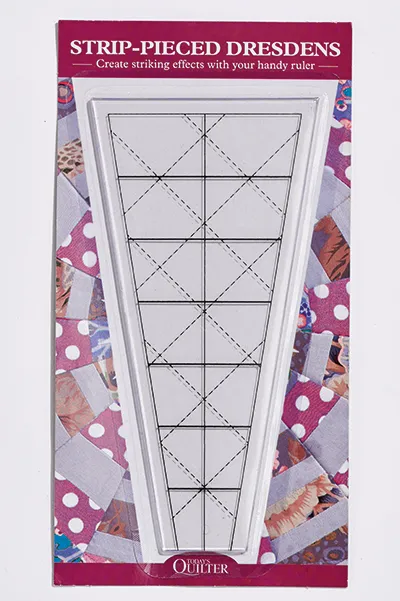Back in early 2019 we featured a handy strip-pieced Dresdens ruler with our issue 45 to help you piece Dresden Fans or Plates. Whether you're a reader who's got the ruler and is looking for ideas for how to use it, or you're a quilter looking for inspiration for how to get more effects from the basic Dresden plate pattern, this post is for you!
Our Technical Editor Laura Pritchard is here to share eye-catching design ideas for how to create different strip-piecing effects with your Dresden Plate units.

Don't have the ruler?
Never fear! Simply download our Dresden Plate Template and you can use it to try all the techniques in this post. Or treat yourself using the links below...
Where to buy Dresden Rulers
We featured the above ruler with issue 45 of Today's Quilter magazine, which is no longer available. But fear not! You can buy Dresden rulers easily online and in local haberdashery stores. We've added some links to this post if you'd like to treat yourself!
How to use your Dresden template
Step 1
Piece together strips of your desired width(s) to make a strip-pieced unit. Markings on our ruler are spaced 1in apart, so to make a strip-pieced unit with single-width stripes, cut 11⁄2in strips of fabric. To make a strip-pieced unit with double-width stripes, cut 2½in strips of fabric and so on.
Your stripes can all be the same width or you can choose to vary them if you prefer. To create a vertical half-and-half wedge, piece two (2) 23⁄8in strips together.
You can create a unit that’s the full length of the ruler (7½in tall), or use fewer strips to create a small Dresden Fan or Plate. Stagger your strips by approximately 1in if you are using your ruler on the 45-degree angle to avoid wastage.
Step 2
Place your ruler on the strip-pieced unit with its markings aligned with your seams. The ruler can be positioned straight with seams running horizontally or vertically, or on a 45-degree angle in either direction.
Play around to create different effects. Mixing and matching will create some interesting patterns.
Step 3
Guide your rotary cutter around the edges of the ruler to cut out your wedge. You will need five (5) wedges for a Dresden Fan and twenty (20) wedges for a Dresden Plate. A full-size Plate will fit onto a 20in square (finished size) background block and a Fan will fit on a 10in block.
How to sew Dresden Plates
If you're completely new to sewing Dresden Plates and Fans, head to our Beginner's Guide tutorial to learn the ropes before you start experimenting with the methods in this post.

Strip-pieced Dresdens: Design ideas
The ends of your Dresden wedges can be finished in several ways. Keep the top straight, and turn under the edge or use fusible web when appliquéing it on to a background. Alternatively, create a pointed end by folding a wedge in half lengthways, right sides together, and stitching across the top with a ¼in seam. Clip the bulk, turn right-sides out and press to create the point. A third idea is to use a rounded object to mark a curved petal effect at the end. This can be turned under during appliqué or again used with fusible web.
As described above, your ruler can be placed on a strip-pieced unit in a number of ways to create different designs:

Two strips of contrasting shades pieced together and cut into a wedge on the vertical, can create a pleated flower effect.

As strip-set of single strips (cut 11⁄2in wide) can be used to create a graded flower, or different striped effects.

Wedges cut at 45-degrees can result in a spinning sawtooth design, or by alternating direction you can create a radiating star pattern.

Pieced strips of varied widths can produce myriad compositions – try varying the seams that you line up your markings with. The possibilities really are endless, so enjoy experimenting to mix and match – a sample quilt of different Dresden Plates would be a delight!
In need of more inspiration? Laura Pritchard shows you how to create this strip-pieced Dresden table runner (below) in issue 45 of Today's Quilter magazine. Get her tutorial straight to your computer, phone or tablet by searching 'Todays' Quilter' in the Google Play or Apple Newsstand app stores.

